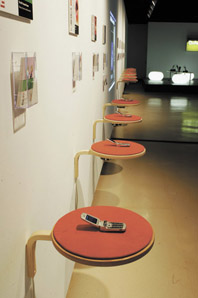Cell Break
Lizzie Muller is mobiled at d>Art 05
 Art.05″>
Art.05″>
d>Art.05
photo Patrick Neu
d>Art.05
In 2004, for the first time, dLux staged their annual d>Art exhibition of web and sound art at the Sydney Opera House Gallery. I reviewed that show (RT 62, p28), and was struck by how the use of such prime exhibition real estate brought these elusive artforms very visibly to new audiences. This year d>Art 05 was back in the Opera House and the web and sound art was joined by a similarly intangible set of works for 3G cell phones commissioned through Mobile Journeys, the initiative of a consortium of arts and industry organisations to develop creative content for mobile devices.
It’s a strange experience to walk into an exhibition and not, at first, be able to see most of the art. Instead the show appeared as a shrine to gadgetry with hints of the Telstra showroom; six iPods delivered the sound pieces, three PCs displayed the web-based works and nine Samsung 3G cell phones, each nestling on a red suede podium, housed the mobile art. The room was full of invisible little artworks trapped inside indistinguishable devices and the process of reaching them (“Step one: press the menu select key, Step two: choose the file icon….” etc.) was laborious.
But getting to the phone works was worth the persistence. Behind the identical interfaces lay an array of creative experiments with this new platform. The most effective pieces played with the qualities native to the technology; intimacy, communication, the projection of private worlds into public spaces, and the possibilities of the small-scale. All the works were tiny, but the best of them were great in their exploration of the miniature.
Tanya Vision’s provocative series of video pieces, Ache Me, engaged with the mobile phone’s illicit potential; its ability to whisper in your ear, to vibrate discretely in your pocket, to, as the Vodaphone ad suggests, get the flirting over before you get home. Her sugary pink movies worked through a series of suggestive transitions, from close-up see-through underwear to the hole of a gleaming iced donut, from the inference of a nipple to melting ice cream. These naughty little visual tricks worked beautifully on the mobile’s miniature screen where their tininess enhanced the ambiguity of the imagery and the effect of a whispered visual secret.
Tina Gonsalves’ one minute movie, Breaking Up, portrayed the disintegration of a relationship through the metaphor of an unreliable phone connection, with an economy of scale that perfectly fitted the mobile platform. Snatches of failed conversation (“I can’t hear you”, “You’re breaking up”, “What?” “We’re breaking up?”) were stuck discordantly together over the blips and fizzes of telecommunication. On the screen an animated figure collaged from random body parts, with oversized mouth and hands, alluded to the way technologies render our bodies as disproportionate versions of ourselves, in this case as talkers and texters.
Traces by Megan Heyward explored the potential of mobile phone art to be intimately site specific. A series of short monologues, in different voices, linked personal memories to particular places. Reminiscences of childhood days at Lunar Park, wild Mardi Gras nights on Oxford Street and adolescent adventures on Anzac Bridge were illustrated with atmospheric visuals that glimpsed Sydney landmarks through someone else’s eyes. The most interesting was the description, by Will Saunders, of the day he painted the famous “No War” protest on the roof of the Opera House in 2003. Saunders’ softly spoken account of the event and the sensational aerial TV footage reproduced on the tiny screen, juxtaposed the scale of the event’s public impact with the personal experience of the act.
Though its location within the Opera House Gallery gave Traces an extra layer of signification, the work was intended and, like many of the other Mobile Journeys commissions, could be enjoyed best by getting out and about with the art in your pocket. All of the phone works were available to ‘take away’ via Bluetooth, if your phone was suitably enabled. Not only was my Nokia from the 90s not enabled, but it was too embarrassed to come out of my handbag. And here’s the rub. Mobile phones make for a lousy gallery display and this is not really the way the artworks are meant to be seen. But, as yet, most people aren’t technologically ‘enabled’, and with 3G download prices continuing to be astronomical, it’ll be a while before many of us are consuming, let alone creating, this kind of content. There is also the lingering question; do people want 3G? If we could afford it, would we all be running around using our phones as video cameras and players?
Whether or not this technology becomes commonplace in the future, right now it’s clear that the possibilities of the form offer an imaginative catalyst for artists. Mobile Journeys gave a glimpse of the kinds of artwork that might fill up our handsets if and when we catch up with the technology. As with last year’s show, d>Art 05 willingly sacrificed the intended context of the artworks to bring them to public attention in a static exhibition. The show was an intriguing glimpse of where artists might go when, and if, the 3G cell phone’s tiny screen breaks out into the great big world.
Mobile Journeys, d>Art 05, Exhibition Hall, Sydney Opera House Gallery, Aug 10-Sept 4
RealTime issue #69 Oct-Nov 2005 pg. 25






